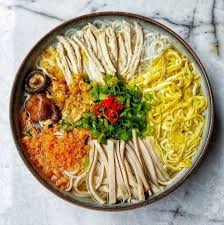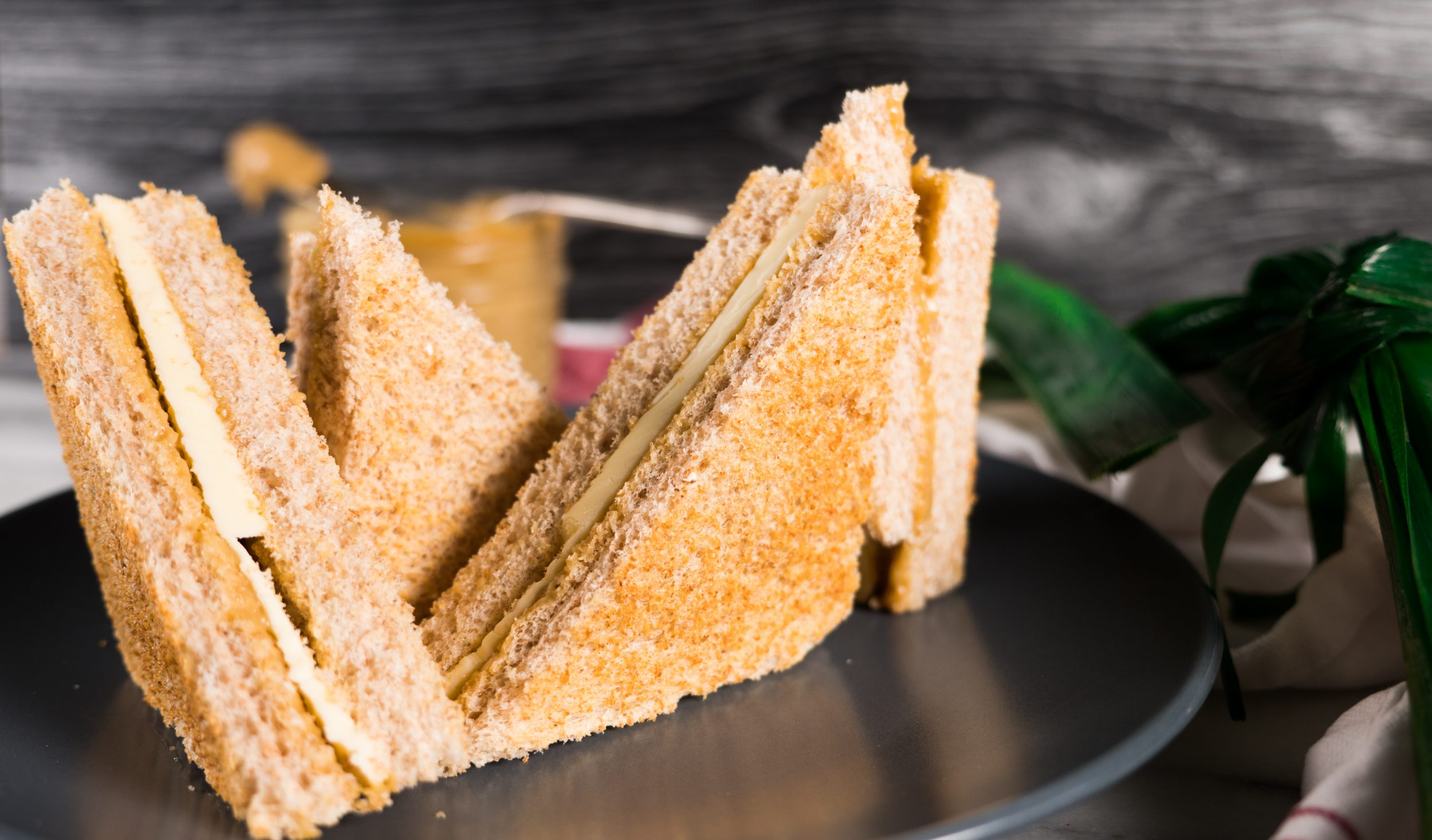Hey if you come to Vietnam for travel, make sure you have breakfast, because your stomach is small, if you skip breakfast, you skip 1/3 of the joys.
Breakfast is extremely important to Vietnamese people. Traditionally, most Vietnamese were farmers who woke up early to work and avoid the heat of the sun, making breakfast a crucial meal to provide energy for their heavy labor. As a result, breakfast in Vietnam often contains a lot of carbohydrates
In this post, I’ll share twelve Vietnamese breakfast dishes that you must try to truly eat like a local.
Some of them are soupy foods that require you to sit down and eat, while others are what busy locals grab on the go.
1. Phở (Vietnamese Noodle Soup)
Phở is a traditional Vietnamese noodle soup made with a flavorful broth, rice noodles, herbs, and meat, typically beef or chicken.
Vietnamese people often eat phở for breakfast because it’s a hearty and energizing way to start the day, providing warmth and sustenance for the morning ahead. You can find phở almost everywhere in Vietnam, from upscale restaurants to small street stalls, and even served by vendors with mobile carts.
Cost: It could vary anywhere from $1 to $5, depending on the level of fanciness of the place you choose to eat.
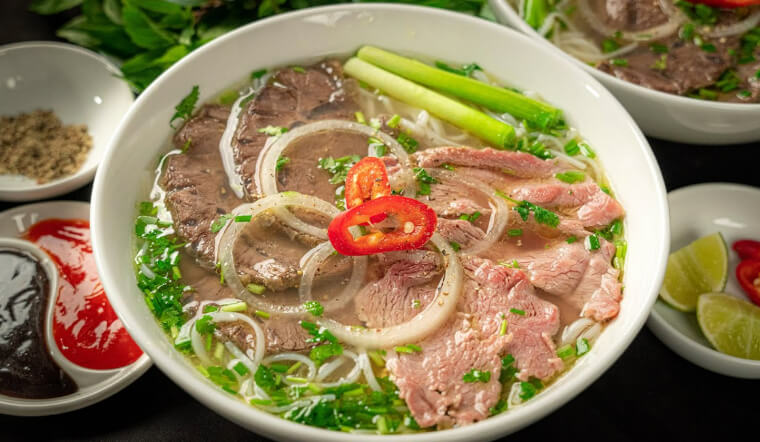
2. Bánh Mì (Vietnamese Baguette Sandwich)
Bánh mì is a Vietnamese baguette sandwich filled with a variety of ingredients such as meats, pickled vegetables, pâté, and herbs.
Vietnamese people often eat bánh mì for breakfast because it’s quick, convenient, and portable, making it ideal for busy mornings. You can easily find people in street walking and eat banh mi at the same time.
You can find bánh mì everywhere in Vietnam, from street vendors and small cafes to bakeries, ensuring a delicious and satisfying start to the day
Cost: %0.5 to $3.
3. Xôi (Sticky Rice)
Sticky rice, known as xôi in Vietnamese, is a popular breakfast dish made from glutinous rice often served with a variety of toppings such as mung beans, pork, or eggs.
Some people like eating Sticky rice with meat base topping such as fatty port, Vietnamese harm, pork floss. Some people enjoy sticky rice with beans, green bean, black bean, peanut or even corn.
Vietnamese people enjoy sticky rice for breakfast because it provides a filling and energy-packed start to the day, ideal for those heading to work or school. You can find delicious variations of xôi at markets, street vendors, and local eateries throughout Vietnam, offering both savory and sweet options to suit different preferences.
Cost: $0.3 to $3
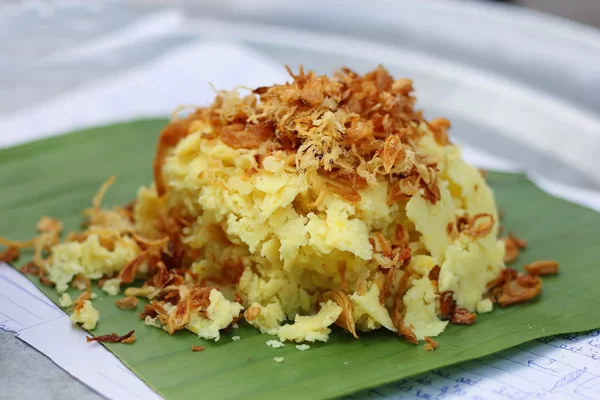
4. Bánh Cuốn (Steamed Rice Rolls – Flat)
Bánh cuốn is a traditional Vietnamese dish consisting of thin, steamed rice sheets filled with minced pork, mushrooms, and shallots, served with dipping sauce.
Vietnamese people favor this dish for breakfast because of its light yet flavorful nature, making it a refreshing start to the day.
You can enjoy authentic bánh cuốn at local eateries and street stalls across Vietnam, where it is freshly made and served hot, ensuring a delightful and authentic culinary experience.
Watching the local making this dish is also a truly local experience for you when travel to Vietnam.
Cost: $0.3to $3
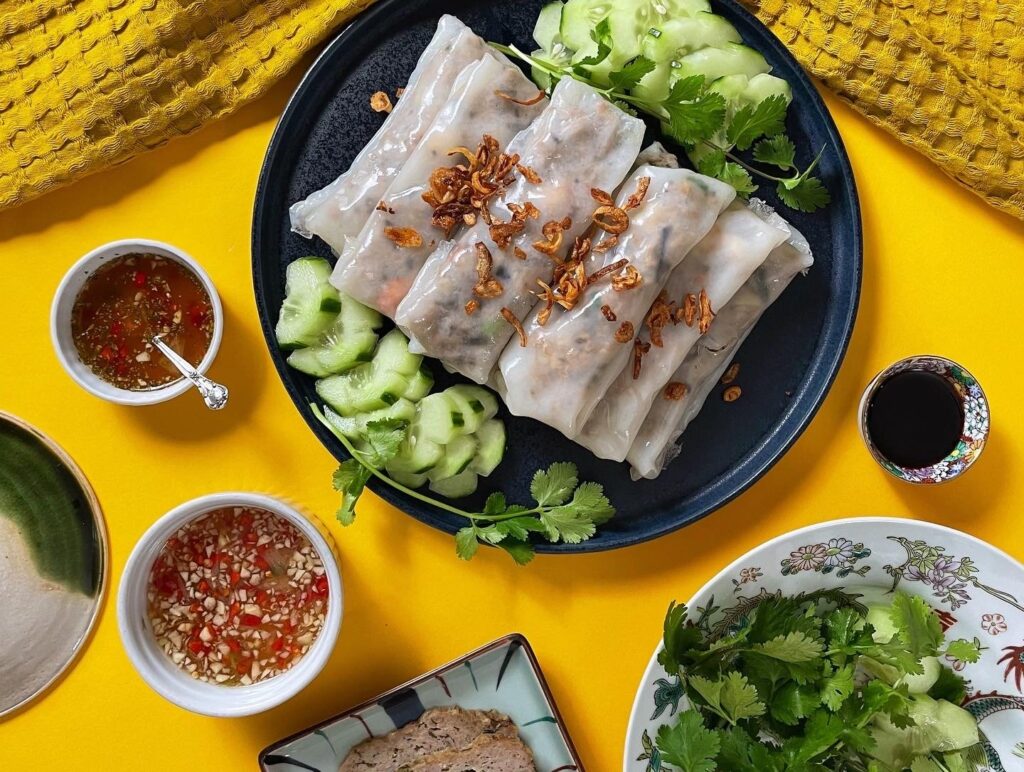
5. Cháo (Rice Porridge)
Porridge, known as cháo in Vietnamese, is a comforting breakfast dish made from rice cooked until it reaches a creamy consistency.
Cháo is typically prepared with meat, bones, or mushrooms to enhance flavor and is served with a variety of toppings such as chicken, pork, fish, or clam. Vietnamese people appreciate cháo for breakfast due to its soothing and nourishing qualities, especially enjoyable on cooler mornings or when feeling under the weather.
Adding chili flakes, pepper, and fresh herbs to a hot bowl of porridge in on a cool winter morning enhances the experience.
You can find delicious cháo at family-run shops, local eateries, and markets throughout Vietnam.
Cost: $0.5 to $3
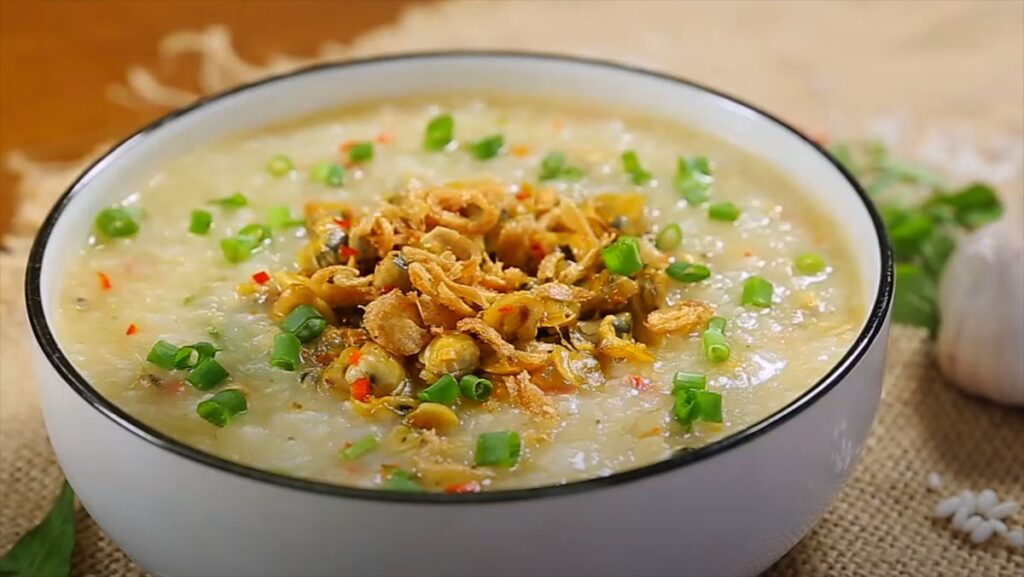
6. Bún Thang (Hanoi-style Vermicelli Soup)
Bún Thang is a specialty Hanoi-style vermicelli soup known for its intricate preparation.
This complex soup features delicate rice vermicelli noodles served with chicken, pork, egg, and aromatic herbs, creating a harmonious blend of flavors and textures.
Bún Thang is cherished in Vietnamese cuisine for its light yet satisfying nature, making it a popular choice for breakfast, especially in Hanoi. You can savor this traditional dish at specialty restaurants throughout Hanoi, where it’s prepared with meticulous attention to detail to capture the essence of northern Vietnamese flavors.
Actually, the history of bún thang originates from holiday leftovers. The people of Hanoi transformed these leftovers into a light noodle dish. It was so good that it has endured to the present day and become a popular dish.
This dish is not as popular as Pho or Banh my, but it worth trying to tastes the local flavors.
Cost: $1-$3
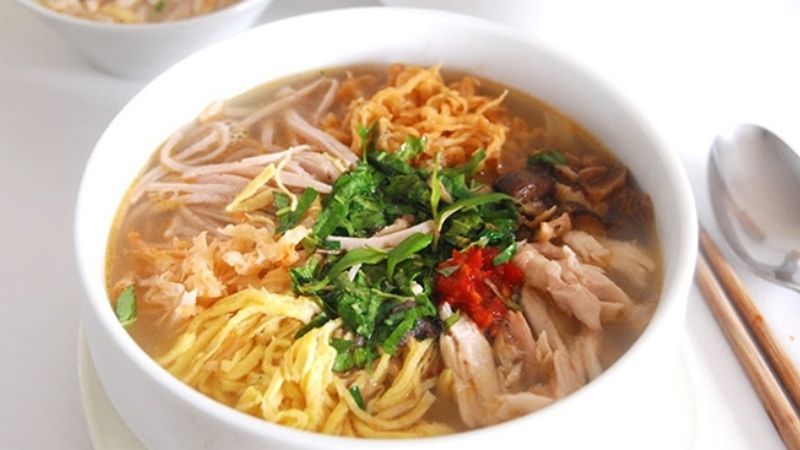
7. Bánh Bao (Steamed Bun)
Steamed buns, known as bánh bao in Vietnamese, are soft and fluffy buns filled with savory ingredients like minced pork, mushrooms, and sometimes eggs or vegetables.
These buns are a popular choice for breakfast in Vietnam due to their convenience and satisfying taste. Vietnamese people enjoy bánh bao as a quick and portable morning snack, often found at street vendors, bakeries, and local markets throughout the country.
The buns are steamed to perfection, ensuring a light and airy texture that complements the rich filling inside.
You can buy steamed buns at small mobile stalls along the streets. Sometimes, people sell steamed buns from motorbikes, and if you’re lucky, you might come across one.
Cost: $0.3to $2
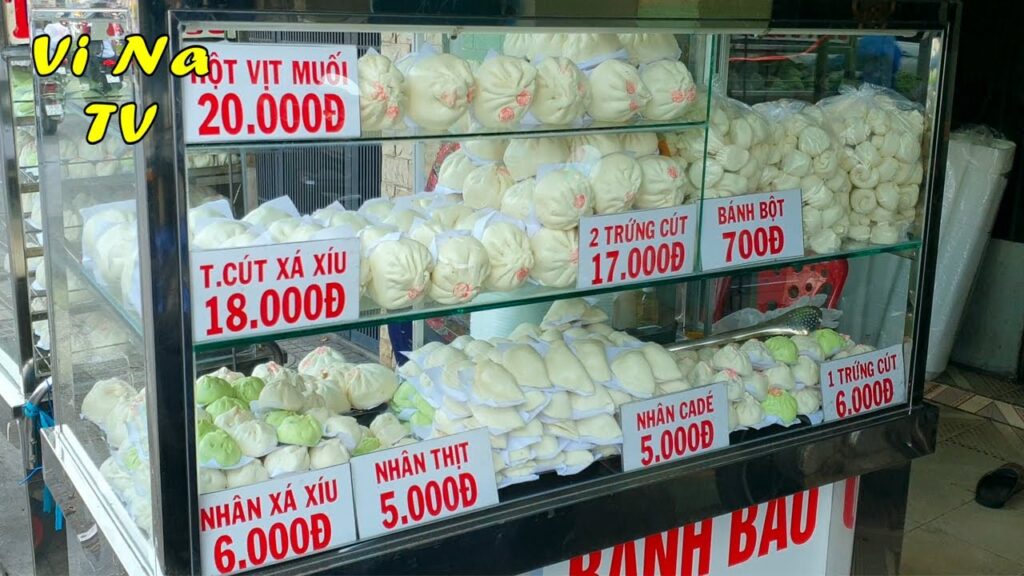
8. Balut (Fertilized Duck Egg)
Balut is a delicacy in Vietnamese cuisine consisting of a fertilized duck egg that is boiled and eaten from the shell. The egg contains a partially developed embryo, which is considered a delicacy by many. Balut is typically enjoyed as a snack or light meal, especially in southern Vietnam, where it’s commonly sold by street vendors.
It’s known for its rich, savory flavor and unique texture, making it a culturally significant and often adventurous culinary experience for those willing to try it.
Vietnamese people enjoy balut with a mix of salt and pepper, a squeeze of lime or kumquat, thinly sliced ginger, and Vietnamese coriander. This combination creates the perfect balance of creaminess, saltiness, umami, sourness, spiciness, and fresh herbal aroma.
Cost: $0.2 to $0.5 each
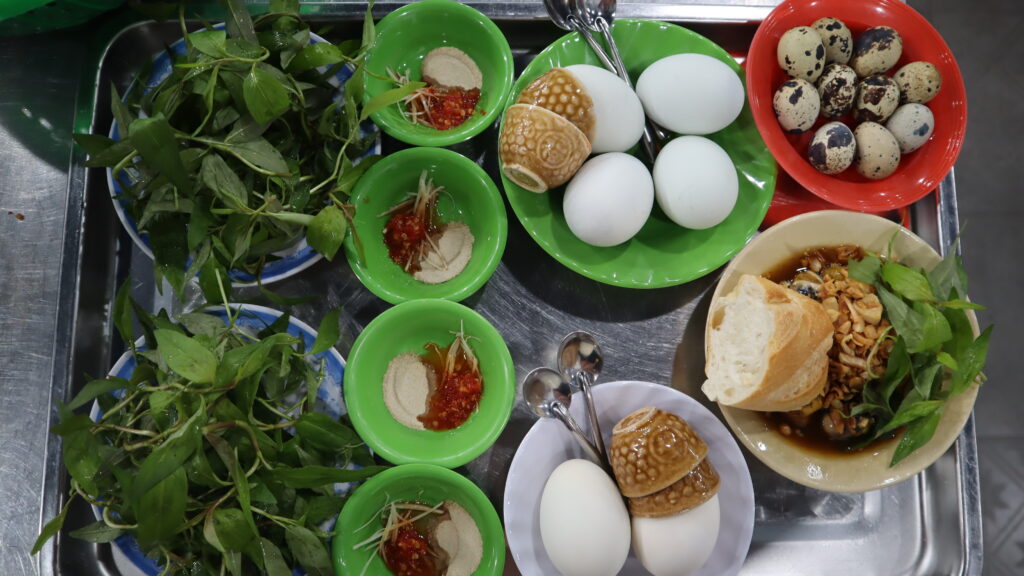
9. Bún – Noodle (Various Vermicelli Dishes)
Vietnam offers a rich variety of noodle dishes, each with its own unique flavors and regional specialties. Among them are Bún Bò Huế, a spicy beef noodle soup known for its robust broth and tender beef slices; Bún Ốc, a snail noodle soup celebrated for its tangy broth and fresh snails; Bún Cá, a fish noodle soup featuring light and fragrant broth with tender fish fillets.
Banh da cua, a Hai Phong dish, features a broth made from freshwater crabs and thick, chewy noodles. Bun lòng is a noodle dish served with intestine soup. Each province seems to have its own variation of noodle dishes, but they are all perfect for breakfast.
These noodle dishes are cherished for their diverse ingredients and distinctive regional preparations, enjoyed at specialty shops, street vendors, and local eateries across Vietnam.
Price: $0.7 to $3
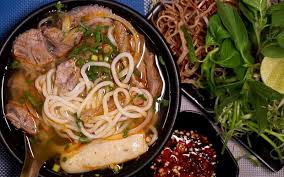
10. Cơm Chiên (Fried Rice)
Apart from eating out at the restaurants or food store, Vietnamese also eat at home with Fried rice, made from leftover rice, known as Cơm Chiên in Vietnamese cuisine.
It is a popular way to repurpose cooked rice into a delicious and satisfying meal. Typically stir-fried with various ingredients such as vegetables, eggs, and often meat or seafood, Cơm Chiên offers a practical and flavorful option for breakfast.
Vietnamese people appreciate this dish for its versatility and ability to transform leftovers into a tasty and nourishing breakfast choice. You can find Cơm Chiên served at home kitchens and local eateries throughout Vietnam, ensuring a delightful start to the day with minimal waste
Cost: 0 if you make it at home, $1.2 to $3 if you buys at restaurant
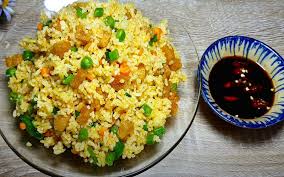
11. Banh chung
Bánh Chưng is a traditional Vietnamese rice cake made from glutinous rice, mung beans, and pork, wrapped in banana leaves and steamed for several hours.
It is typically prepared during Tết (Lunar New Year) celebrations and holds significant cultural symbolism, representing the Earth. But it is also enjoyed for every breakfast. The Banh chung for new year is oftenly bigger and a whole family of 4-5 barely can finish one banh chung at once. But Banh chung for breakfast is smaller and made into one person size.
Bánh Chưng is enjoyed for its hearty, savory flavor and dense texture, often sliced and served as a special dish during festive gatherings and family reunions.
Price: $0.3 tp $0.5 each
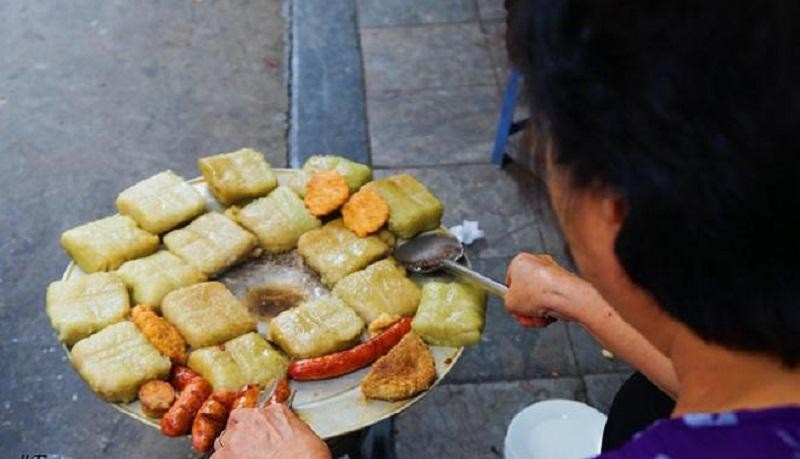
12. Steamed sweet potatoes, steamed corn
Beside the complicated dishes, Vietnamese also eat real simple foods for breakfast, which are Steamed sweet potatoes and steamed corn, especially in rural areas where they are readily available.
Sweet potatoes are prized for their natural sweetness and satisfying texture when steamed to perfection. Similarly, steamed corn offers a comforting sweetness and crunch that complements morning meals. Both dishes are cherished for their simplicity, affordability, and nutritional benefits, making them popular choices among Vietnamese people looking for a hearty and wholesome start to the day. You can find steamed sweet potatoes and corn sold by street vendors or at local markets throughout Vietnam, ensuring a delightful taste of traditional breakfast fare.
Price: $0.3 to $1
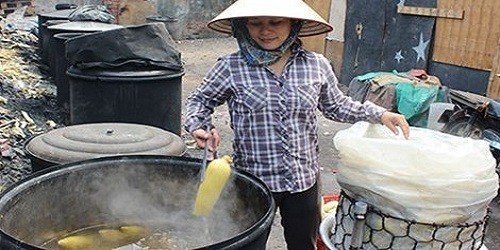
Left over from the day before
This is not a dish, but this is popular among the population, Using leftovers from last night’s dinner for breakfast is a practical and sustainable choice embraced by many Vietnamese households.
Whether it’s leftover grilled meats, stir-fried vegetables, or even rice dishes, repurposing these foods ensures minimal waste while offering a quick and convenient morning meal.
Vietnamese cuisine values resourcefulness and flavor, making leftover dinners a delightful option for breakfast. Families often enjoy transforming these dishes into new creations or simply reheating them for a familiar and satisfying start to the day, showcasing Vietnam’s culinary ingenuity in making the most of every meal
Those are what truly local eats and maybe you should try!
Vietnamese breakfast dishes are as diverse as they are delicious, each offering a unique taste of the country’s rich culinary heritage. I encourage you to explore these dishes when visiting Vietnam to experience breakfast like a local truly.
HMZ
